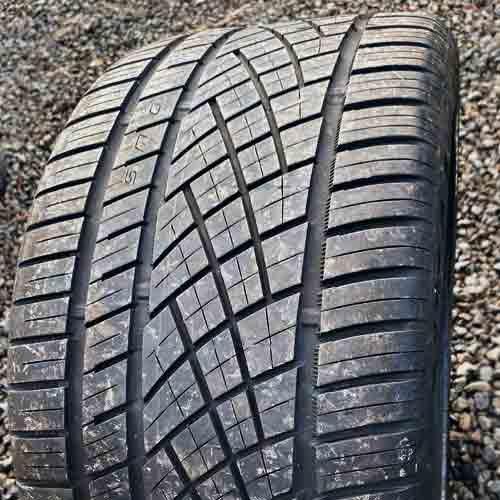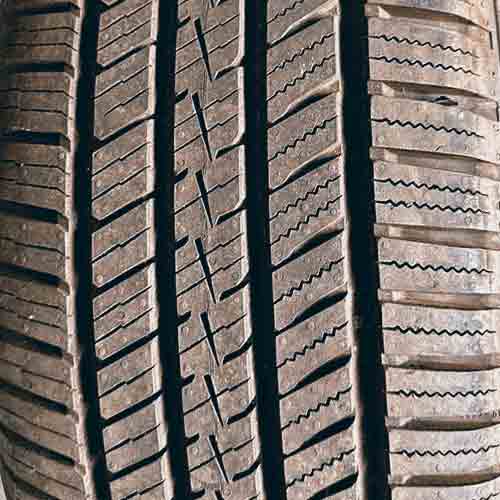Both the Vredestein Hypertrac AS and the Continental ExtremeContact DWS06+ are classified as ultra-high-performance all-season tires. However, although they offer excellent traction and responsive steering, there are important details you should be aware of. Let me give you an idea about them.

Table of Contents
Main Highlights
So overall, the Hypertrac AS is better at:
- Lateral Traction: Providing superior side-to-side grip during turns.
- Noise Reduction: Where its actually one of the quietest tires in its category.
- Ride Smoothness: Offering a smoother driving experience, effectively cushioning road bumps.
Whereas the ExtremeContact DWS06+ is better at:
- Dry Braking: Excelling in braking performance with an efficient tread design.
- Wet Performance: Offering outstanding hydroplaning resistance and overall wet traction, excelling particularly in wet handling.
- Fuel Efficiency: Due to its lighter construction and reduced tread bending.
Tread Features
The Continental ExtremeContact DWS06 Plus sports an asymmetric tread pattern that’s pretty unique.

Now the tire comes with a 4 rib/block column design, where the central (widest of all) rib is more voided up.
This rib have a lot of squared-off blocks with (plus-shaped) sipes, oriented towards multiple angles, providing (wet) grip in all directions.
Moreover, these lugs also form a web of grooves running around in all directions.
The neighboring central narrower rib, comes with laterally arranged notches and sipes, along with snow vices (which is also common with 2 other ribs).
And the shoulders?
Well they are similar on each side, almost.
Both ribs carry lateral grooves, and sipes on them.
Though one side has more off-set edges, while the other has snow-vices.
The Vredestein Hypertrac AS, also with an asymmetric tread pattern, is characterized by five distinct rib or block columns.

Here, the central (most) rib is continuous-running, with sharp longitudinal notches and lateral siping for superior grip, and is notable for its bidirectional notches.
Flanking this are two ribs with divergent designs, where one mirrors the central rib’s siping and features squared-off lugs, while the other distinguishes itself with offset edges and wave-like siping for varied traction.
The shoulder lugs continue this very same theme of siping variation, though they are densely arranged.
As you can see, these lugs carry ridges between them, connecting all blocks longitudinally.
This design basically adds to the tire’s handling stability and lateral traction.
Side Note: If you’re new here, and needing that perfect all-season tire for yourself, I’ve got a better place for you to start. Check this out: https://tiredriver.com/all-season-tires/
Info on Sizes
The Continental ExtremeContact DWS 06+ come with sizes in 16 to 22 inches rims, having following specifications.
- Speed ratings: W and Y.
- Load ratings: SL and XL only.
- Tread depth: 10/32″ on all.
- Weight range: 18 to 35 lbs.
- Treadwear warranty: 50k miles.
- UTQG rating: 560 AA.
- Internal Construction: 2 ply polyester with twin steel belts, reinforced by a single ply nylon.
Review Continental’s tire here: https://tiredriver.com/continental-extremecontact-dws-06-plus-review/
The Vredestein Hypertrac comes in 16 to 20 inches rims. And these sizes have following specs.
- Speed ratings: W and Y only.
- Load ratings: SL and XL.
- Tread depth: 10.7/32″ on all.
- Weight: 20 to 40 lbs.
- UTQG: 500 AA A.
- Treadwear warranty: 50k miles.
- Internally, the tire offers 2 ply polyester casing with twin steel belts, reinforced by a single ply polyamide layer on very top.
Review this tire here: https://tiredriver.com/vredestein-hypertrac-all-season-review/
Dry-Road Performance
Dry performance is essentially divided into three main parts: dry grip, handling, and steering response. Let’s explore each of these components individually.
Linear Grip
When talking about tire grip, the middle part of the tread is super important, as this is where most of the tire’s weight sits, when it’s rolling straight.
And considering that, it makes sense why the the Vredestein Hypertrac All Season could use a boost in its braking power (that’s how we measure linear grip).
The thing is, this tire is a bit heavier, which means it builds up more momentum and doesn’t stop as quickly, even though it has these continuous ribs that touch the road a lot.
On the flip side, the Continental ExtremeContact DWS06 Plus is nailing it, as it strikes a great balance between stopping and going fast.
In tests, it’s actually one of the best at braking fast among high-performance all-season tires. This is all thanks to its smart tread design.
Sure, it has a bunch of grooves that take away some rubber (contact patch), but they’re really helpful, as they act as in-groove notches, providing grip in all directions, adding to the tire’s overall braking efficacy.
Overall Handling
Handling is all about how well a tire sticks to the road (lateral grip) plus how it responds to steering.
Now, when we talk about lateral traction, which is how a tire moves side-to-side, the shoulders of the tire are key. They’re the parts that really hug the road during turns.
Here, the Vredestein Hypertrac AS offers great traction (as seen by its greater average lateral g forces). Though the tire still lacks in overall handling, where it takes half a second more to complete laps on average.
But why is that? Well, it boils down to its steering response.
When you really push the Vredestein to its limits, especially at high speeds, things can feel a bit off.
In other words, when you steer quickly, the front of the car might lose grip, leading to understeer (that’s when your car doesn’t turn as much as you want and keeps going straight).
On the other side, the Continental ExtremeContact DWS06 Plus, while feeling a bit artificial, responds more directly, allowing for a much better feedback, especially in mid-corner turns, and a solid feel after you finish turning.
Side note: In terms of overall handling, the HyperTrac’s performance is actually pretty similar to the General G Max 05 (review).
Wet-Road Performance
For wet performance, the main consideration is how the tire handles water evacuation from its tread, particularly in traction and hydroplaning resistance. Let’s dive into each of these areas.
Wet Grip and Handling
Now, most of the water gets cleared (from underneath the tread, on road), by sipes and grooves.
Now, grooves are awesome for pushing away majority of the water, but it’s the tiny droplets that hang around under the tread blocks that really cause the slips and slides. And that’s where sipes come in.
These small slits that help suck up those little water particles.
Meaning a good enough tire for wet traction needs to have plentiful sipes, which should also be flexible enough to create ample suction, for water particles (left out by grooves).
Now, here, the HyperTrac gets this right with its numerous linear and wavy slits, giving you with faster wet braking, relatively. Though it still lacks in overall handling compared to ExtremeContact DWS06+.
Why? Well, because the Vredestien’s sipes are mainly laterally arranged, which tend to get stiffer with the tire taking harsher maneuvers.
That’s why the tire is prone to slightly oversteering as seen on subjective evaluation, (though its still manageable, FYI).
And just so you know, out of all the ultra-high performance all-season tires I’ve checked out, the Continental nails it in wet handling, offering you with quickest of all lap times.
And yes, the tire offers sipes running in all directions, clearing water form all angles. Though most of its wet handling is contributed to its very effective hydroplaning resistance.
Resistance to Hydroplaning
Now, if water does get removed form the tread, fast enough, a layer of water can build up under the tire, leading to hydroplaning, where the tire sort of “floats” on the water instead of gripping the road.
Now here, the effectiveness of grooves (on the tread) is the most important thing to consider.
Having said that, the Continental ExtremeContact DWS 06+ with its multi-directional web of grooves, provide water pathways in all directions, providing you with superior resistance to hydro or aquaplaning.
And with more water chucking out of the way, there’s less reliance on sipes to begin with. Meaning, the tire improves it overall wet traction with this as well.
Winter Traction
When we look at how both tires handle in winter conditions, they do a pretty solid job.
Though it’s worth mentioning that neither of them has the 3-Peak Mountain Snowflake certification, which is kind of the gold standard for winter performance (particularly snow acceleration). Learn all about 3pmsf and M+S here.
But even without this certification, both boys, still are coming out as strong contenders in their category.
Diving into the details, the ExtremeContactact has the upper hand in ice braking and holds its own in snow braking, too. And yes, it also edges out a bit in acceleration, comparatively.
Though overall snow handling times (as seen on lap tests), are better on Vredestien HyperTrac.
So both tires have their good and areas for improvement here.
The cool thing about the Continental is its in-groove notches and snow vices. These features really help it grab onto slick surfaces and maintain traction by trapping snow.
Whereas the HyperTrac has the edge of its (updated) rubber composition, which is more thermally adaptive.
This means the tire stays more flexible and doesn’t harden as much when it gets really cold, leading to a more consistent grip.
But keep in mind, this advantage is only for tires with a DOT TIN manufacture date of 2721 or later, since these are the ones with the new/improved rubber composition.
Ride Quality
The comfort of driving largely depends on the sound of the tread and how well the tire can cushion road bumps. Let’s explore these two factors one after the other.
Noise Dampening
Tire noise mainly comes from how air particles hit the tread walls. As the tire rolls, air sneaks in, mostly through the shoulders, and smacks into the tread, creating noise.
Knowing this, it’s no surprise that the ExtremeContact DWS 06 Plus, with its more open design, isn’t the best at keeping things quiet.
This is especially noticeable when you compare it to the Vredestein Hypertrac AS, which is actually one of the quietest tires in the ultra-high performance all-season category where both these tires sit.
So what makes this tire better?
Well, for starters, it doesn’t have as many grooves/voids in its structure as the DWS06+.
On top of that, it’s got more optimized design, where its shoulder have ridges that help block air from getting in and it also offers variable pitch sequencing technology.
This tech, creates a mix of sound frequencies that kind of cancel each other out, leading to less noise overall.
Vibrations Comfort
When it comes to how smooth a ride is, tires play a big role by acting like a secondary suspension system, soaking up all the bumps and dips on the road.
In this light, the Continental ExtremeContact DWS 06 Plus, although showcases an impressive handling stability, it’s not quite at the top of its game when it comes to road smoothness, compared to Hypertrac All Season.
You might find the ride in the Continental a bit rough, especially when you’re taking corners, and that can take away from the whole experience.
This is partly because of how it’s built.
I mean, the DWS06+ has this stiff nylon layer inside, wound up in a spiral way. Sure, this makes for some really good steering feedback, but it also means the edges of the tire are pretty rigid.
And this stiffness can make your ride feel a bit shaky, especially when you’re turning.
MPG Efficiency
Tire fuel efficiency is all about how much resistance a tire puts up while rolling. And, a bunch of stuff goes into this, like how heavy the tire is, what it’s made of on the inside and outside, and the kind of rubber used for the tread.
Taking all these into account, it’s easy to see why the Continental ExtremeContact DWS 06+ has a bit of an edge in fuel efficiency, especially when compared to the Vredestein HyperTrac.
Basically, the Continental is lighter, thanks to its less hefty steel belts and has less thicker rubber on top, relatively.
This reduced weight means the lugs are under less stress. And combined with the tire’s shallower tread depth, its lugs are less susceptible to bending.
But why that’s important?
Well, less bending means the tire doesn’t use up as much energy flexing back into shape or generating heat, allowing for better fuel economy.
The Wrap-Up
As we approach the conclusion of our comparison journey, it’s time to summarize and assess how both tires perform in the final analysis.
Here, the Continental tire excels in dry-road braking with its efficient tread design.
And although it also offers superior handling, particularly in steering responsiveness and mid-corner turns, it truly shines in wet traction, particularly in the handling department.
And while the tire has the advantage in snow performance, its lacks on ice compared to its Vredestein tire.
Speaking of which, the HyperTrac provides you with a quieter ride, and offers better impact comfort performance.
And although it offers tread longevity, that is very similar to DWS06, it lacks in providing as much fuel economy, in comparison.